Certificate of Rehabilitation: Cleaning Up Felony Convictions when Expungement Is Not Available
Templates and Forms
 Petition for Certificate of Rehabilitation and Pardon Form - PDF
Petition for Certificate of Rehabilitation and Pardon Form - PDF Notice of Filing of Petition for Certificate of Rehabilitation and Pardon - PDF
Notice of Filing of Petition for Certificate of Rehabilitation and Pardon - PDFThe granting of a Certificate or Rehabilitation restores some of the rights of citizenship that were forfeited as a result of a felony conviction. It may also be used to relieve some persons convicted of sex offenses of their registration requirements (see California Penal Code (PC) § 290.5 for a list of offenses which are not relieved from registration). The granting of a Certificate of Rehabilitation also acts as an automatic application and recommendation for a pardon from the governor.
Receiving a Certificate of Rehabilitation serves as an official document to demonstrate a felon’s rehabilitation; this may enhance the applicant’s employment options, and may be considered by state licensing boards.
Related Guides on Similar Topics
- Sacramento County Superior Courts Criminal Case Dismissal (Expungement) Process
- Understanding the Sacramento Superior Court Expungment Packet
It does not erase or seal the applicant’s criminal record or allow the applicant to state on an employment application that he or she has no criminal convictions. Furthermore, it does not prevent the conviction from being considered for later convictions, for example, in sentence enhancements under the “three-strikes” law, and may be rescinded for subsequent criminal acts.
There is no filing fee to file the Petition for Certificate of Rehabilitation and Pardon, and if you are eligible to file, you are entitled to receive assistance from all rehabilitative agencies, including the adult probation officer of the county, state parole officers, and the youth authority (if you are under 30) (PC § 4852.04). You may represent yourself, be represented by the attorney of your choosing, or by the public defender (PC § 4852.01(a)).
Step-by-Step Instructions
1
Obtain Your Criminal Records
To complete the forms, you will need information regarding each felony conviction that you have, including the date of the conviction, the specific charge or charges for which you were convicted, the county of the conviction, and the sentence that was given. In addition, you will need to know the date that you were released from prison or jail and/or discharged from parole or probation.
This information may be obtained through the court in which the conviction(s) took place, or you may obtain a copy of your state criminal record through the California Department of Justice. You may only obtain your own records from the Department of Justice. Information regarding this request may be obtained through the Office of the Attorney General Web site at the California Department of Justice: Criminal Records – Request Your Own. Regardless of the number of convictions, you will be filing only a single petition.
2
Confirm Your Eligibility
You are ineligible for a Certificate of Rehabilitation if any of the following are true:
Are you eligible for expungement?
- You were convicted only of misdemeanors (other than sex offenses defined in PC § 290, which were subsequently expunged); and/or
Most misdemeanors and “wobblers” (felonies that could have been charged as misdemeanors) may be expunged. Expungement is easier and has more benefits than a Certificate of Rehabilitation. A recent change in the law, Prop. 47, added a number of non-violent felonies to this list. See the Sacramento Superior Courts guide Criminal Case Dismissal (Expungement) Process if you think this may apply to you.
- Were convicted of any of PC §§ 286(c), 287, 288, 288.5, or 289 (j); and/or
- Are serving mandatory life parole; and/or
- Were sent to state prison under a death sentence, and/or
- Are currently in military service.
Assuming that none of the above criteria render you ineligible, the specific requirements for eligibility are listed in PC § 4852.01, but are summarized below:
Release/Discharge Prior to May 13, 1943. You are eligible if you:
- Were convicted of a felony, and released from a California prison or other state institution; and
- Were discharged on completion of your sentence or released on parole prior to May 13, 1943; and
- Have not been incarcerated in a state prison or other state penal institution since release; and
- Have three years of residency in California immediately before filing the petition.
Expunged Felony or Misdemeanor Sex Offenses. You may apply for a Certificate of Rehabilitation if you:
- Were convicted of a felony or misdemeanor sex offense specified in PC § 290, but subsequently expunged the conviction pursuant to PC § 1203.4; and
- Have not been incarcerated since expungement; and
- Are not on probation for any other felony, and
- Have five years plus the additional period of rehabilitation specified in PC § 4852.03 of residency in California immediately prior to the filing of the petition:
- Two years (for a total of seven years) if convicted of PC §§ 311.2(a)-(d), 311.3, 311.10, or 314;
- Five years (for a total of ten years) if convicted of any other offense requiring sex offender registration.
Convicted on or After May 13, 1943. You may be eligible for a certificate rehabilitation if you:
- Were in state prison on May 13, 1943 for a felony, or convicted of a felony after May 13, 1943, and served time in a state prison or other state institution or agency; and
- Have five years plus the additional period of rehabilitation specified in PC § 4852.03 of residency in California immediately prior to the filing of the petition:
- Four years (for a total of nine years) if you were convicted of violating PC §§ 187, 209, 219, 4500, 18755, or California Military and Veterans Code § 1672(a), or any other offense which carries a life sentence (PC § 4852.03(a)(1)).
- Two years (for a total of seven years) for any other offense not described.
3
Complete the Required Forms
Instructions for completing the necessary forms are included at the end of this packet. Two forms are needed to petition for a Certificate of Rehabilitation. They may both be picked up free of charge from the Gordon D. Schaber Courthouse at 720 Ninth Street, Sacramento, in Room 102 at the criminal filing counter, or downloaded from these links.
4
Make Copies of the Documents
Make two copies of the Petition for Certificate of Rehabilitation and Pardon (FORM 1) as well as the Notice of Filing of Petition for Certificate of Rehabilitation and Pardon (FORM 2).
Two-hole punch the top of the original, and staple each copy, and place the two copies underneath the original of each document.
5
File Your Documents
File your Petition for Certificate of Rehabilitation and Pardon (and two copies) and present your Notice of Filing of Petition for Certificate of Rehabilitation and Pardon (and two copies) at the criminal filing desk in Room 102 of the Courthouse at 720 Ninth Street. There is no filing fee for filing these documents. The court will assign a hearing date, time, and department, and note these on the Notice of Filing of Petition for Certificate of Rehabilitation and Pardon (FORM 2), or otherwise notify you of the hearing date. The court clerk will stamp and return the copies of the Petition to you.
6
Serve Notice of Filing of Petition for Certificate of Rehabilitation
You must notify (1) the Governor’s Legal Affairs Office and (2) the District Attorney in each county where you were convicted of an offense for which you want a Certificate of Rehabilitation. They must be notified at least 30 days prior to the hearing. This is done by providing each person with a copy of the Notice of Filing of Petition for Certificate of Rehabilitation and Pardon. The Notice may be served by mail, or delivered in person with acknowledgement of receipt, or by a combination of the two. Make additional copies of the filed Petition for Certificate of Rehabilitation and Pardon so that you have enough to provide the Governor’s Office and each District Attorney with a copy.
Service by mail:
To have the Governor’s Office or a District Attorney served by mail, you must have someone over the age of 18 who is not a party to the case (i.e., not you), mail a completed copy of the Notice of Filing of Petition for Certificate of Rehabilitation and Pardon (FORM 2). As a courtesy, a copy of the Petition should be sent as well. Information about the server and the details of the mailing are written on the Affidavit of Service by Mail (page 2 of the Notice).
The person who served the Notice and Petition must then attest under penalty of perjury that he or she mailed the documents as stated in the Affidavit of Service by Mail in front of a notary (that is, the server must sign the Affidavit of Service by Mail in front of a notary). The notary then signs the Affidavit of Service by Mail. This allows the court to have confidence that the person who mailed the Notice and Petition is who they claim to be.
If you were convicted of all crimes in Sacramento County, the addresses for service are:
Governor’s Office
Attn: Legal Affairs
State Capitol
Sacramento, CA 95814
Sacramento County District Attorney
901 G St.
Sacramento, CA 95814
Delivery in person:
Service to the Governor’s Legal Affairs Office or the District Attorney(s) may also be performed in person. Have someone over the age of 18 who is not a party to the case (i.e., not you) deliver a copy of the Notice of Filing of Petition for Certificate of Rehabilitation and Pardon (FORM 2), and preferably a courtesy copy of the Petition, to the office being served, and have the person accepting service acknowledge the delivery on the Notice of Service In Person sheet (page 3 of the Notice).
7
File the Notice of Filing of Petition with Signed Proof of Service
Once the Governor’s Office and the appropriate District Attorney(s) have been served, make two copies of the Notice of Filing of Petition for Certificate of Rehabilitation and Pardon and the attached Affidavit of Service and/or Notice of Service in Person, and file the original plus the two copies with the court at 720 Ninth Street, in Room 102. The court will stamp and return the copies.
8
Attend the Court Hearing
Make sure to attend the court hearing as the judge will make a determination as to whether to grant the Certificate of Rehabilitation. Be prepared to discuss in detail the aspects of your crime, and your life afterward. You may be represented by a private attorney of your choosing, the Public Defender’s Office, or you may represent yourself. It is your responsibility to prove your reformation to the court.
9
Automatic Application for Governor’s Pardon
If you are granted a Certificate of Rehabilitation, it serves as a recommendation for pardon. Your Application and Certificate of Rehabilitation will automatically be forwarded to the Governor’s office for consideration of your request.
For help
Sacramento County Public Defender
700 H Street, Ste. 0270
(916) 874-6411
Services Provided: Assistance with Certificates of Rehabilitation
Samples
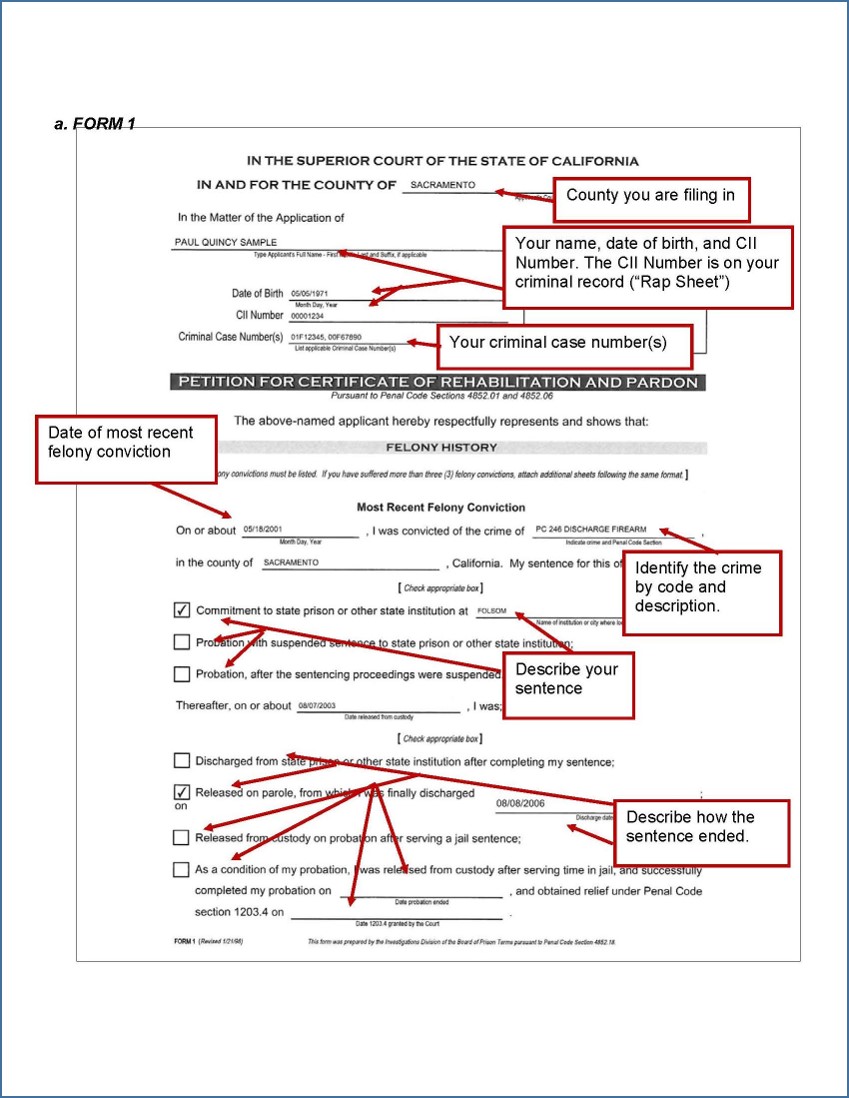
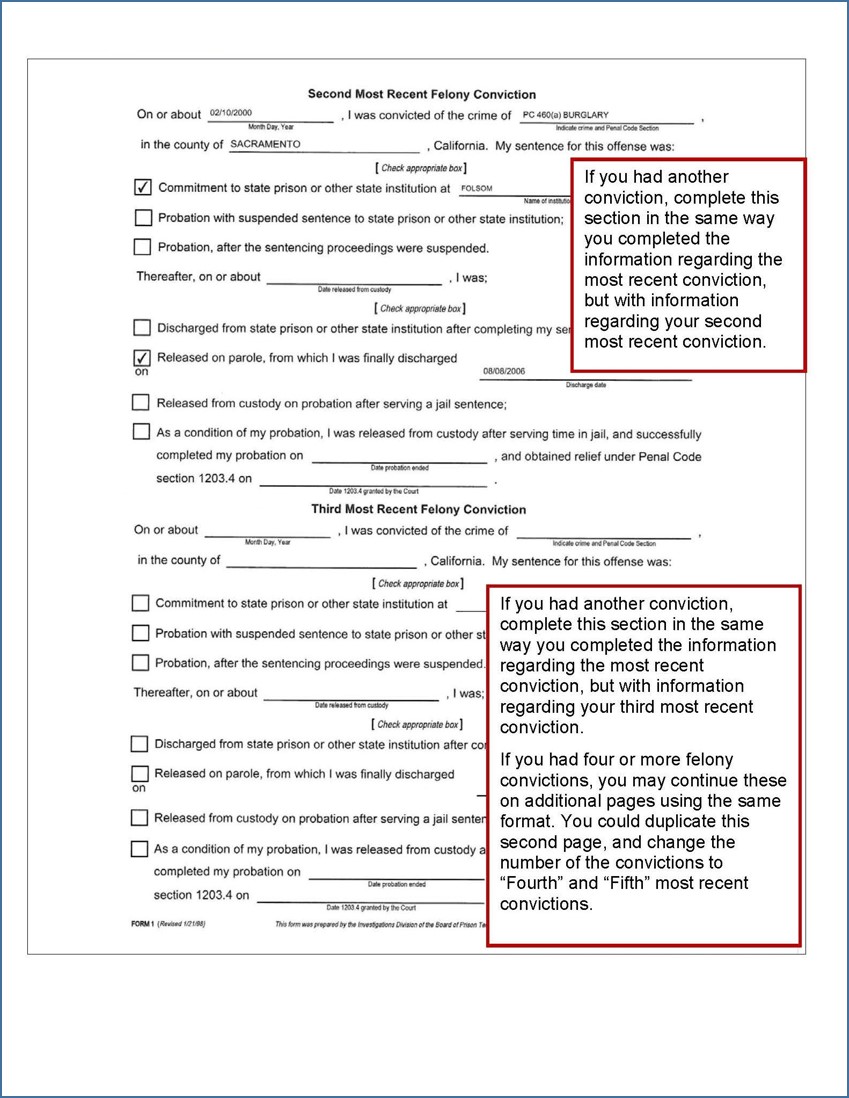
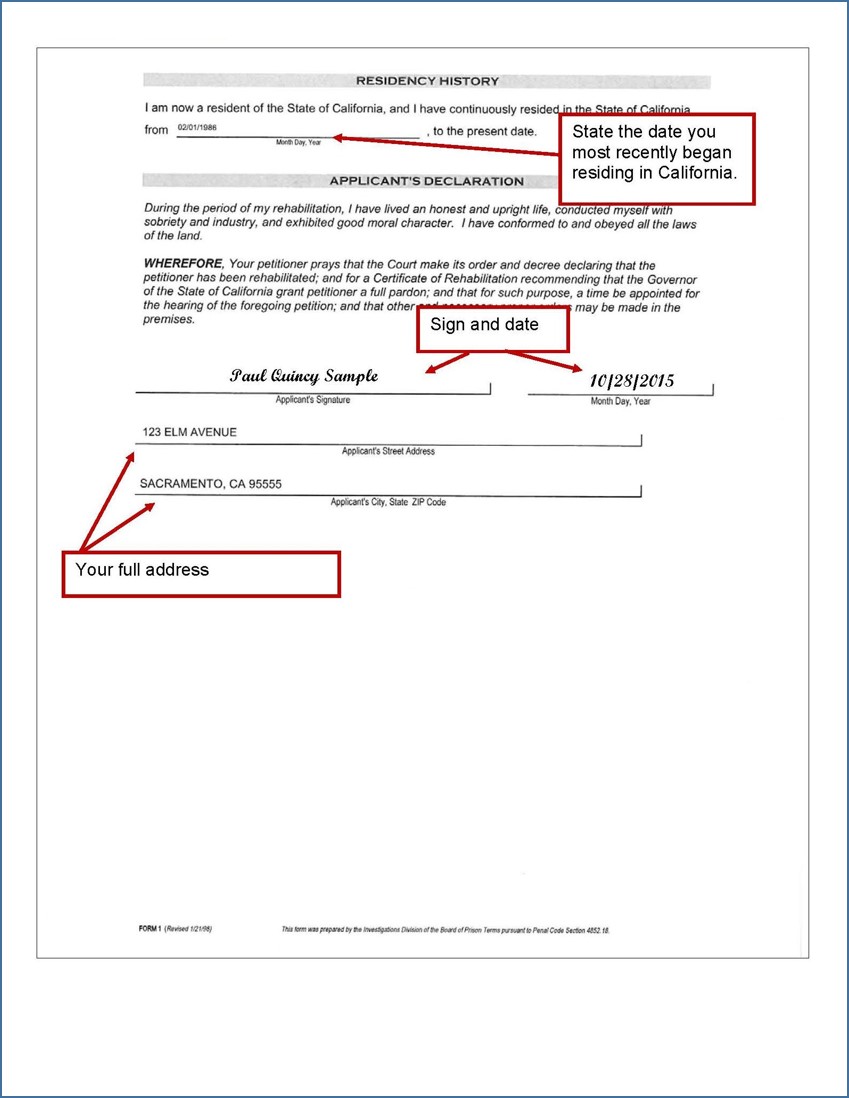
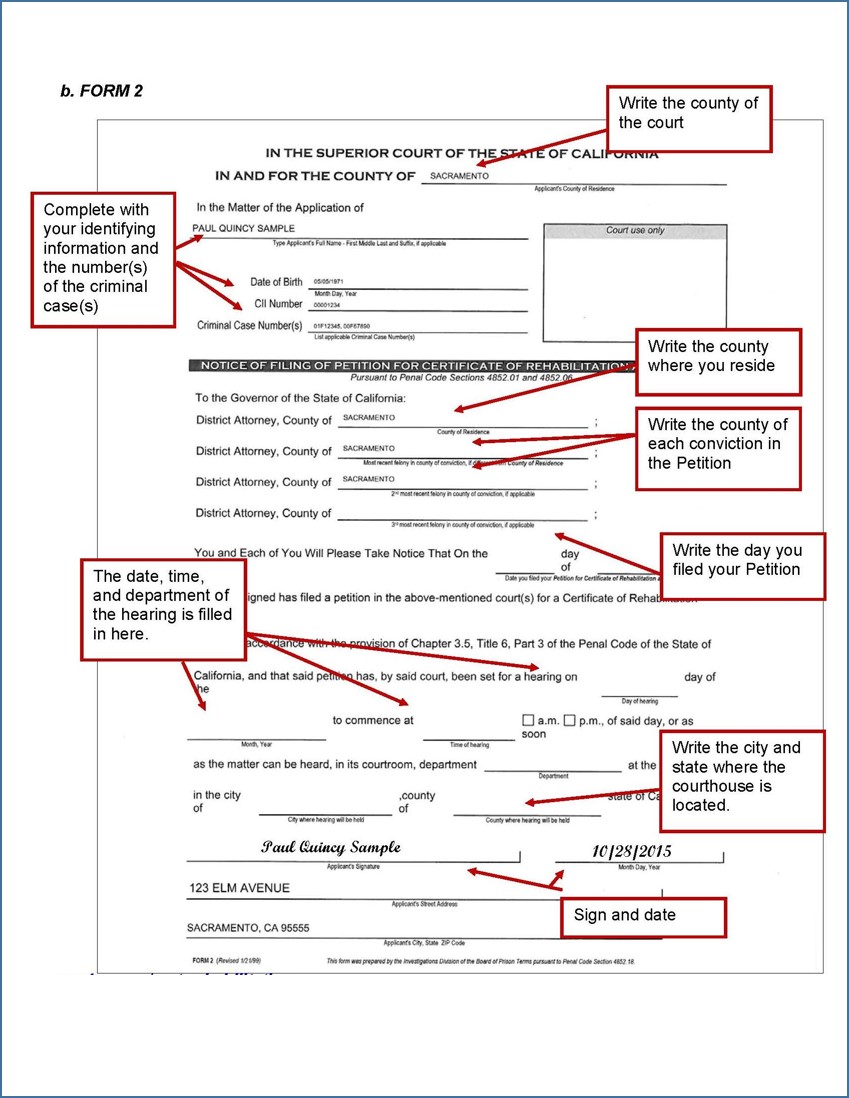
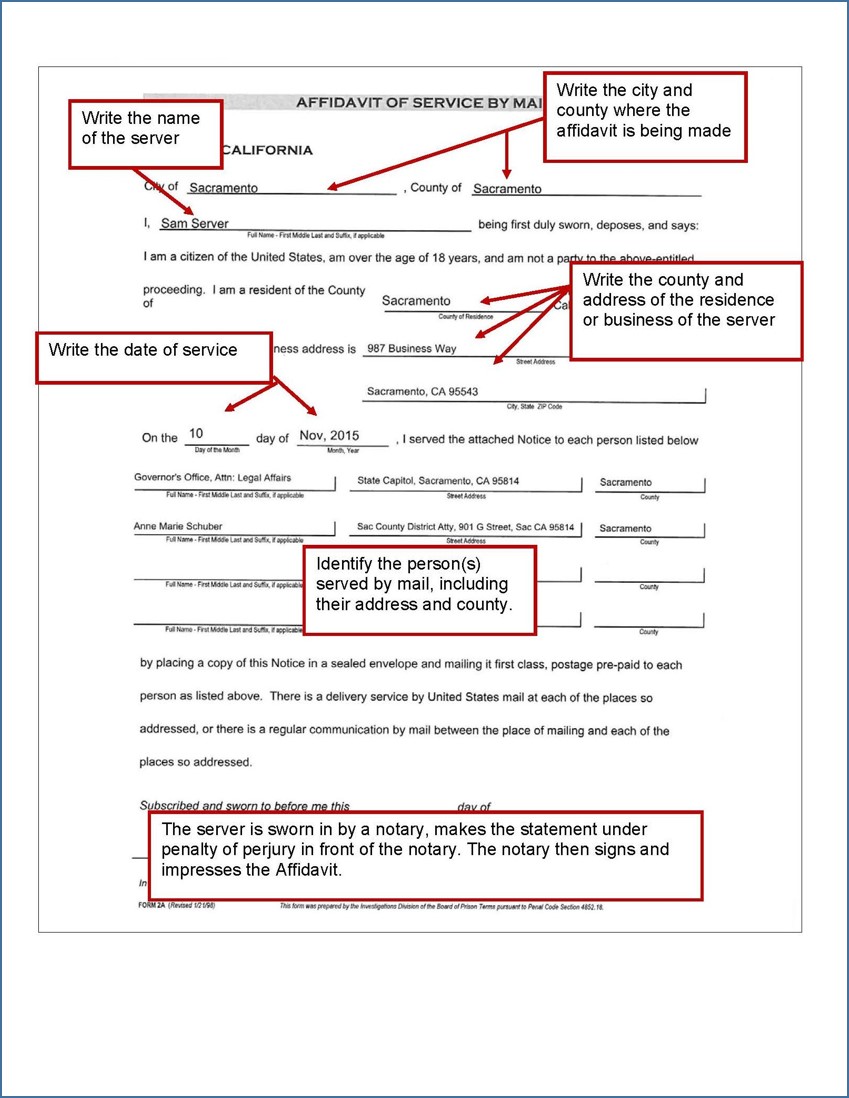
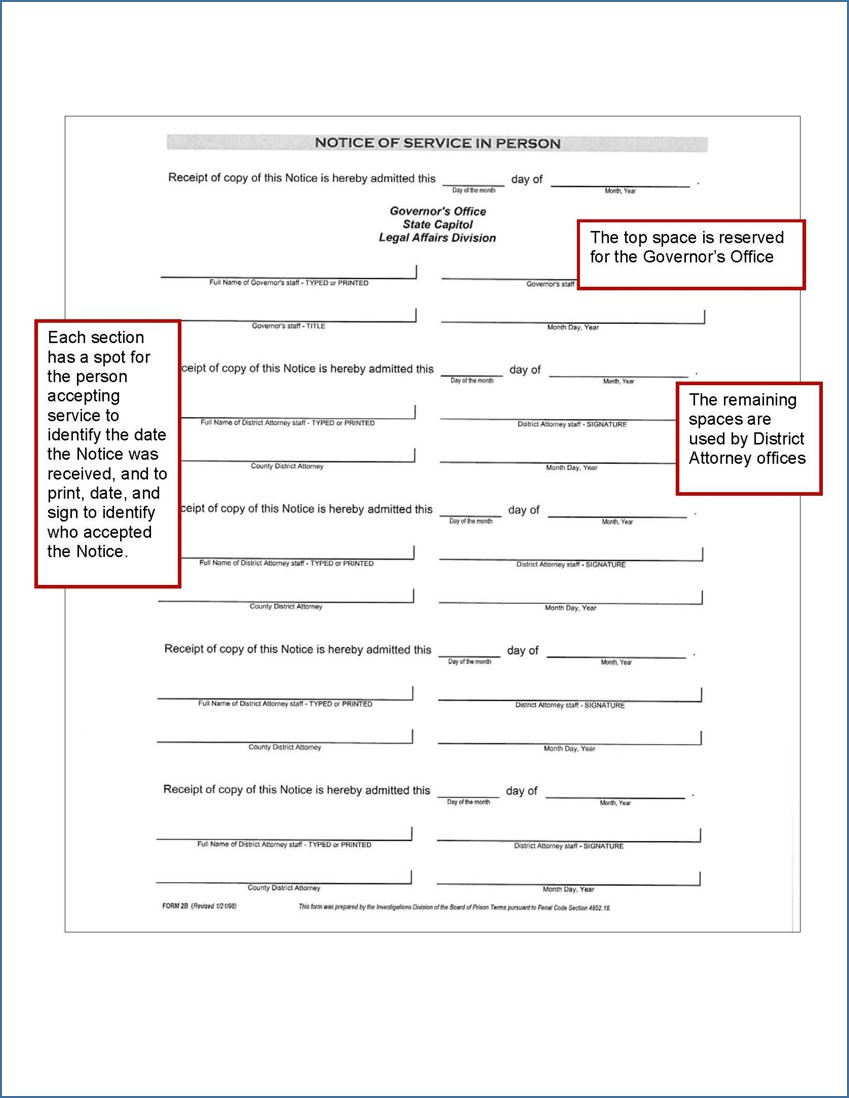
This material is intended as general information only. Your case may have factors requiring different procedures or forms. The information and instructions are provided for use in the Sacramento County Superior Court. Please keep in mind that each court may have different requirements. If you need further assistance consult a lawyer.





